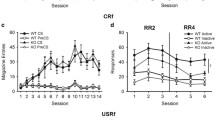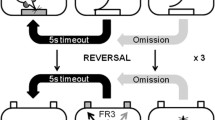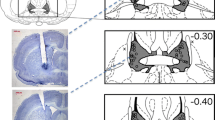Abstract
Rationale: Previous experiments have shown that rats whose 5-hydroxytryptaminergic (5-HTergic) pathways have been destroyed exhibit higher rates of switching between response alternatives on various temporal differentiation schedules. Objective: This paper reports two experiments investigating the effect of central 5-HT depletion on switching between concurrent schedules of reinforcement which do not entail temporal differentiation of behaviour. Methods: Rats received injections of 5,7-dihydroxytryptamine into the dorsal and median raphe nuclei or sham lesions. They were trained to press levers for sucrose reinforcement. In experiment 1, the rats were exposed to concurrent pairs of variable-time (VT) schedules specifying equal inter-reinforcement intervals; responses on a single ”changeover lever” alternated between the two VT schedules. In experiment 2, the rats were exposed to concurrent pairs of variable-interval (VI) schedules specifying equal inter-reinforcement intervals; responses on one lever (”VI lever”) earned reinforcers, while responses on the other lever (”changeover lever”) alternated between the two VI schedules. Results: In experiment 1, both groups showed longer ”dwell-times” (intervals between successive changeover responses) when a reinforcer was delivered in the ”dwell” than when no reinforcer was delivered (”win-stay” effect). The lesioned rats showed higher rates of changeover responding and shorter dwell-times (with and without reinforcer delivery) than the sham-lesioned group. In experiment 2, the rate of responding on the VI lever did not differ significantly between the two groups; however, the lesioned rats showed higher rates of changeover responding, shorter dwell-times (with and without reinforcer delivery) and smaller numbers of inter-changeover responses on the VI lever than the sham-lesioned group. In both experiments, the levels of 5-HT and 5-hydroxyindoleacetic acid were reduced in the brains of the lesioned rats, but the levels of noradrenaline and dopamine were not altered. Conclusions: These results provide further evidence for the involvement of the ascending 5-HTergic pathways in behavioural ”switching”, and indicate that this is not restricted to temporal differentiation schedules.
Similar content being viewed by others
Author information
Authors and Affiliations
Additional information
Received: 28 September 1998 / Final version: 1 December 1998
Rights and permissions
About this article
Cite this article
Al-Ruwaitea, A., Chiang, TJ., Ho, MY. et al. Effect of central 5-hydroxytryptamine depletion on changeover behaviour in concurrent schedules of reinforcement. Psychopharmacology 144, 264–271 (1999). https://doi.org/10.1007/s002130051002
Issue Date:
DOI: https://doi.org/10.1007/s002130051002




